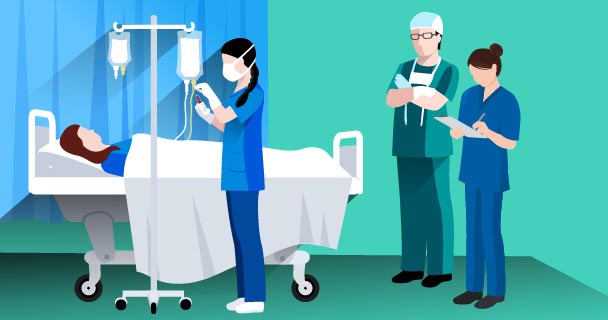blog


Leader rounds should not be done merely as a way to follow protocol; they should be done with a purpose. Leaders should perform rounds to collect actionable information from patients and staff and to promote a “people-centered” culture across the organization. While several strategies can make rounds more purposeful, a key driver is effective communication.
A Model for Leader Rounding
This is where our model for leader rounding and communication, RELATE, can become a useful tool for providers. While this model is commonly used to guide interactions between care providers and patients, it is just as important during interactions between hospital staff. When used during leader rounds, the RELATE model is a simple way to obtain and share actionable information.
Reassure – This step distinguishes our model from others in the industry. 96% of patients report having fears when going into the hospital. Leaders must make a proactive effort to reduce fears by being present and empathetic during rounds. Specifically, they should make a connection with patients, introduce themselves and their function, and tell the patient how long they’ve been with the organization. A similar approach should be taken for employee-centered rounds to help ease any anxiety or fears among staff.
Explain – Leaders should narrate care, explaining what rounding is and why it occurs without using any technical, medical jargon. Employees should understand that rounding is a way for leaders to evaluate their own performances and those of other employees to ultimately improve care delivery.
Listen – Communication is a two-way street. Leaders should encourage staff to express concerns, ask questions, and be mindful of not judging anything that is said. Since many patients and staff have fears that keep them from speaking up, reading body language and other nonverbal expressions is an essential part of “listening.”
Answers – During rounds, leaders should validate any questions that are asked and clearly restate information. Through paraphrasing or teach-back activities, leaders can ensure that staff and care providers understand what is being explained or asked.
Take Action – After gathering feedback during rounds, leaders should address any concerns that come up and start to build a well-informed action plan. The focus here should first be on managing staff expectations, and then on taking proactive steps to exceed them.
Express Appreciation – At the end of their interaction, it is important that leaders thank employees, explain how they will be following up, and reiterate how nice it was to get to know them and understand their concerns.
Common Challenges to Purposeful Leader Rounding – A Six Step Solution
Six steps – sounds easy enough, right? Unfortunately, while this model assists during the actual rounding process, there are many challenges before the process even begins. First, leaders will not prioritize rounding if they fail to see the value that it brings to hospital performance. It is important that clinically validated findings, such as those of Johns Hopkins, are voiced throughout the hospital to demonstrate the link between leader rounding and high-quality patient care.
Perhaps the most obvious constraint to purposeful leader rounding is time. With the countless tasks that hospital leaders manage behind the scenes to improve care services, it can be challenging to find the time for frontline activities. For this reason, patient care must be thoughtful and effective without being overly time-consuming. Our suggestion, and a growing trend in the healthcare industry, is to replace traditional pen-and-paper documentation with a digital rounding tool to streamline the process.
HealthStream’s learning management system and healthcare training solutions support medical training initiatives and allow for the best patient care.
View All Learning & PerformanceExpand the decision-making skills and effectiveness of your healthcare workforce with HealthStream's workforce development programs and services.
View All Clinical DevelopmentComprehensive, industry-leading provider onboarding and credentialing software that validates health outcomes and supports provider assessment.
View All CredentialingMake sure your healthcare staff can schedule out appointments and work schedules with ease using our line of nurse scheduling software solutions.
View All SchedulingWhen you enact HealthStream's quality compliance solutions, you can do so with the confidence your healthcare organization will meet all standards of care.
View All Quality & ComplianceTransform end-to-end revenue cycle management with comprehensive education
View All Revenue Cycle EducationLearn about our advanced resuscitation training solutions. Our solutions are designed to help improve patient outcomes.
View All Resuscitation